Defend Against the Evil Eye: Discover Protection and Power!
- Details
- Written by CrystalWind.ca
- Views: 12714

The evil eye refers to an illness passed on, often unintentionally, by someone feeling envy, jealousy, or covetousness.
It's known by various names across different cultures. In Hebrew, it's called ayin ha'ra, in Yiddish ayin horoh or ayin hora, and in Italian mal occhio. In Spanish, it's mal ojo or el ojo, in Sicilian jettatore, and in Farsi, bla band.
The belief in the evil eye is a superstition that spans various cultures and has been around for centuries. It is based on the idea that certain individuals have the power to cause harm or bad luck to others simply by looking at them with envy or admiration. This harmful gaze is believed to be able to affect not only people but also animals, crops, and other possessions.The belief in the evil eye is a superstition that spans various cultures and has been around for centuries. It is based on the idea that certain individuals have the power to cause harm or bad luck to others simply by looking at them with envy or admiration. This harmful gaze is believed to be able to affect not only people but also animals, crops, and other possessions.
The term "evil eye" can be misleading, as it implies a deliberate curse or ill intent. However, in many cases, the person casting the evil eye may not even be aware of their actions or the potential harm they are causing. The belief is more about the unintended consequences of jealousy or envy than about malicious intent.
In some cultures, the belief in the evil eye is deeply ingrained and can influence everyday behavior. People may take precautions to protect themselves from the evil eye, such as wearing talismans or amulets, or performing rituals to ward off its effects.
Overall, the belief in the evil eye reflects a broader cultural belief in the power of thought and intention. It serves as a reminder to be mindful of our thoughts and feelings towards others, as they can have unintended consequences.
Evil Eye Belief: Origins and Distribution
Many books have been written about the evil eye. The classic 19th century text is "The Evil Eye: The Origins and Practices of Superstition" by Frederick Thomas Elworthy. A short popular survey is"Terrors of the Evil Eye Exposed" (reprinted as "Protection from Evil") by Henri Gamache. The most thought-provoking academic essay I have found on the psychology and the distribution of this belief in world cultures is "Wet and Dry: The Evil Eye" by Professor Alan Dundes, who teaches at the University of California, Berkeley. The article can be found in two of his books, "Interpreting Folklore" and "The Evil Eye: A Casebook," the latter a collection of scholarly writings assembled as a text for his anthropology-folklore students.
Dundes theorizes that the evil eye, which has a Middle-Eastern, Mediterranean, and Indo-European distribution pattern and was unknown in the Americas, Pacific Islands, Asia, Sub-Saharan Africa or Australia until the introduction of European culture, is based upon underlying beliefs about water equating to life and dryness equating to death. He posits that the true "evil" done by the evil eye is that it causes living beings to "dry up" - notably babies, milking animals, young fruit trees, and nursing mothers. The harm caused by overlooking consists of sudden vomiting or diarrhoea in children, drying up of milk in nursing mothers or livestock, withering of fruit on orchard trees, and loss of potency in men. In short, the envious eye "dries up liquids," according to Professor Alan Dundes - a fact that he contends demonstrates its Middle Eastern desert origins.
As Dundes points out in support of this theory, evil eye belief is geographically spread out in a radiating ring from ancient Sumer, where it apparently got its start. It is mentioned the Torah (the Old Testament of the Bible) and its existence is acknowledged by modern Arabs, Jews, and Christians. The belief extends eastward to India, westward to Spain and Portugal, northward to Scandinavia and Britain, and southward into North Africa. Although many people of European descent think it is universal, in fact China has no evil eye belief - nor does Korea, Burma, Taiwan, Indonesia, Thailand, Sumatra, Vietnam, Cambodia, Laos, Japan, Australia (aborigine), New Zealand (aborigine), North America (native), South America (native), or any of Africa south of the Sahara. It is generally referred to by scholars as a Semitic and Indo-European belief. The Westernmost pre-Columbian outpost of evil eye belief was along the Atlantic coast - Ireland, England, Scotland, Spain, Portugal, and France; the easternmost pre-Columbian outpost of evil eye belief was India.
The epicentre of currently active evil eye belief is in nations along the Mediterranean and Aegean shores, plus India and the South American countries most influenced by Spanish conquest. It is now a fairly widespread belief among indigenous people in Latin America. Colonialists also spread it to North America, Australia, and New Zealand.
Although it was not a part of the belief-system of sub-Saharan Africans, slaves brought to the New World picked up the evil eye belief from contact with Europeans. In mid-20th century America, "Terrors of the Evil Eye Exposed" by the popular occultist Henri Gamache (author of the better-known "Master Book of Candle-Burning"), was extensively marketed to African-Americans. As with the similarly Jewish-inspired booklet "Secrets of the Psalms" by Godfrey Selig, the Middle-Eastern and Indian folklore Gamache "exposed" was syncretised into African-American hoodoo practices.
Almost everywhere that the evil eye belief exists, its effects are said to occur as an inadvertent side-effect of envy or praise. A typical account of such a mishap might be: "I dressed the baby in new clothes and took him to town and a woman who has no children saw him and said, 'Oh, what a pretty child!' and as soon as we got home he began to vomit!" The "evil" in these accounts of the evil eye indicate that it is thought to be situational in nature and that it is caused by a failure to restrain envy within proper social bounds.
Mentions of the evil eye (ayin ha'ra) in the Bible clearly refer to the role that envy and covetousness play in its development. We can read in Proverbs 23:6 "Eat thou not the bread of him that hath an evil eye, neither desire thou his dainty meat" and likewise in Proverbs 28:22, "He that hasteth to be rich hath an evil eye, and considereth not that poverty shall come upon him."
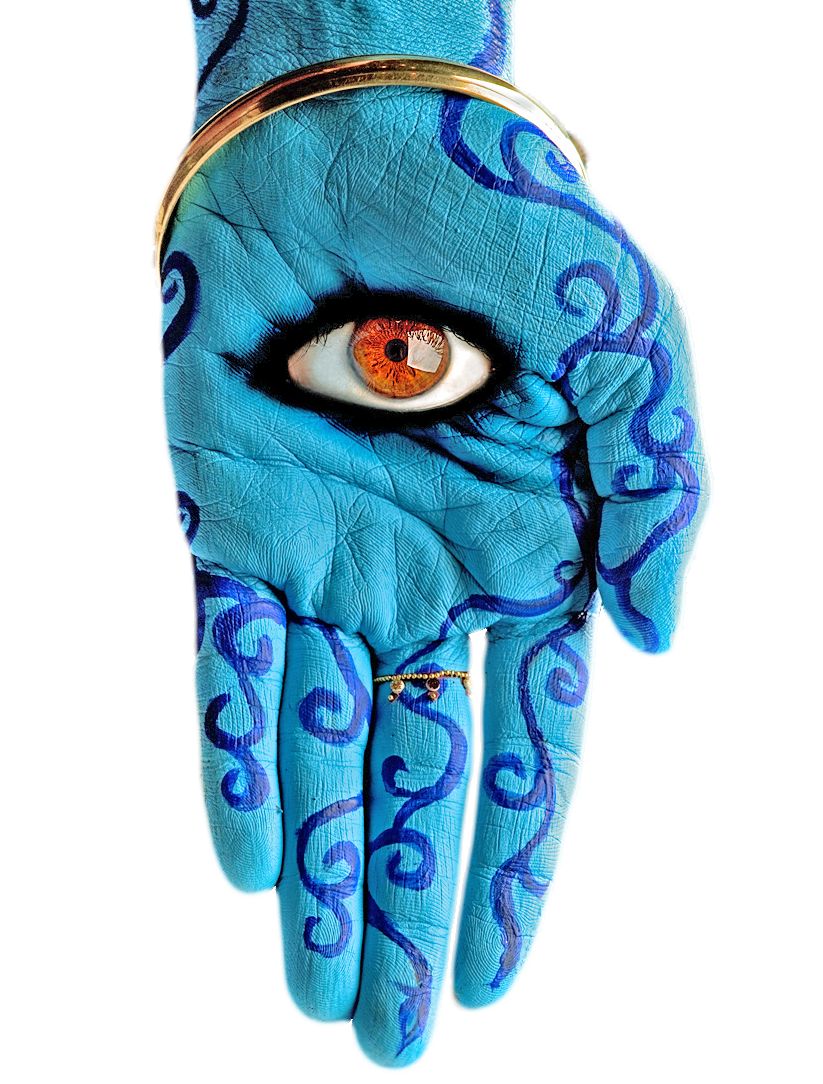
Then over in Mark 7:21-22, we see that the early Jewish Christians believed in ayin ha'ra, for it is written there that when Jesus Christ lectured about defilement, he told his followers that ayin ha'ra comes forth from a man and defiles him just the same as if he had committed a physical crime: "From within, out of the heart of men, proceed evil thoughts, adulteries, fornications, murders, thefts, covetousness, wickedness, deceit, lasciviousness, an evil eye, blasphemy, pride, foolishness."
There is a great deal of attention paid to protecting babies from ayin ha'ra among Jews, and red threads are commonly employed for this purpose. Furthermore, in keeping with Professor Dundes' theory that the evil eye is related to dryness or a loss of fluids, it is interesting to note that Jewish folk belief holds that fishes are immune to ayin ha'ra "because they are covered with water," and that the descendents of a certain man named Yosef Tzaddik (literally Joseph the Righteous, but also a pun with Tzaddi or Fish-Hook) are immune to the effects of the evil eye because he was not jealous - and coincidentally, his name relates to fishes.
Jewish belief in the evil eye has resulted in certain community safeguards to prevent it occurring. For instance, rather than taking a census and thus opening some people to jealousy because they have large families, it was long the custom for each person to simply pay a sheckel (a small coin) to the census taker and let the coins be counted rather than peoples' names written down, to avoid damage from ayin ha'ra. The best month for taking such a coin-census was said to be the month of Adar, which is associated with fishes and the Zodiacal sign of Pisces (The Fishes) - because "fishes are immune to ayin ha'ra."
Preventing jealousy over the size of a family is also at the root of another Jewish custom, that of not allowing a father and son to be called successively to the reading of the Torah in Synagogue. A reason commonly used to explain this custom is that "an orphan in the congregation who has lost his father, or a father who has lost his son, may be reminded of his loss and feel jealousy and give ayin ha'ra." One exception to this custom is made during the month of Adar (Pisces or the Fishes) when, during the Feast of Purim, the Scroll of Esther (Megillat Esther in Hebrew) is read in its lengthy entirety (the whole megillah!) - and not once, but twice, which is such a superfluity of Torah reading that everyone gets a turn and no jealousy will be engendered, and even if someone did get jealous, the event would occur in the month of Adar and "fishes are immune to ayin ha'ra."
Some Jews abjure the notion of ayin ha'ra as "superstition" yet explain it in theological terms, saying, "When someone is jealous, he makes a complaint that is heard by God, and if the person who is being complained against is proud or ungenerous, then God judges him and lowers him."
Only in Sicily and Southern Italy is it believed that some people can DELIBERATELY cast the evil eye on others. There the regionally idiosyncratic belief is that certain people (including at least one former Pope) are born with the evil eye and "project" it involuntarily. Such people are called jettatores ("projectors") and their specific form of evil eye is called jettatura ("projection") in contradistinction to the garden variety of envious or praising evil eye, which in Italian is called mal occhio ("bad eye"). Jettatores are not necessarily evil or envious people, according to this belief system, and they are often represented as being saddened and embarrassed by the harm they cause.
In the eastern Mediterranean and Aegean region, especially throughout Greece and up into Turkey, there is a strong tendency to view blue-eyed people as bearers of the evil eye - probably because few locally-born people have blue eyes and those who do show up, such as tourists, are given to praising and cooing over babies, who are thought to be most at risk from the eye.
Avoiding the Evil Eye through Words and Actions
Because the evil eye is a specific form of evil, the protective charms and spells that have developed around it are also quite specific in nature.
In some countries, if a person feels moved to praise a child, fruit tree, or dairy animal, he or she follows the praise by spitting, under the mother's or owner's approving gaze, to remove the taint of the praise. In other areas, praise of a child can be safely mediated by immediately touching the child, to "take off the eye." If the praiser fails to follow these protocols, the mother may invoke religious aid by uttering a formulaic prayer to obviate the possibility of an evil eye incident, or she may speak ill of the child to counter the damage caused by the praise.
It is important to understand that the person who praises the child is not evil per se, unless envy of the mother's good fortune in having such a lovely child is considered evil. In some cultures attuned to evil eye belief, when someone praises a child, he or she IMMEDIATELY de-fuses the threat by touching the child or spitting on it (notice that this is the application of a liquid to counteract the dehydration caused by the evil eye). In other cultures, any child taken to public places is smeared or daubed with a little dirt and a bystander can then safely praise the child by using the formula, "Oh, the child is so pretty - too bad he has dirt on him" - or if the praise is not thus de-fused, the mother can respond, "He is so dirty right now!"
In Italy, the evil eye is said to affect men as well as children, nursing mothers, fruit trees, and dairy animals. It brings on impotence, through a drying up of the semen. Typical protective aversions of this problem include making the gestures called the mano fico ("fig hand") and the mano cornuto ("horned hand").
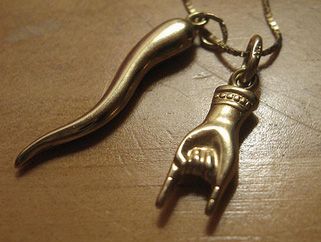
Mano cornuto is a gesture in which the middle and ring fingers are held down by the thumb and the index and little fingers are extended outward like horns. Among some people this is the sign of a cuckholded man, but it is also widely used as a protective gesture against impotency. The mano cornuto is familiar to Americans who read comic books as the gesture Dr. Strange makes when he casts a spell and the gesture Spider-Man makes when he "thwips" web fluid from his wrists. (The popular artist Steve Ditko was responsible for the design of both of these characters, and some comics fans refer to the mano cornuto as "the Steve Ditko hand gesture.")
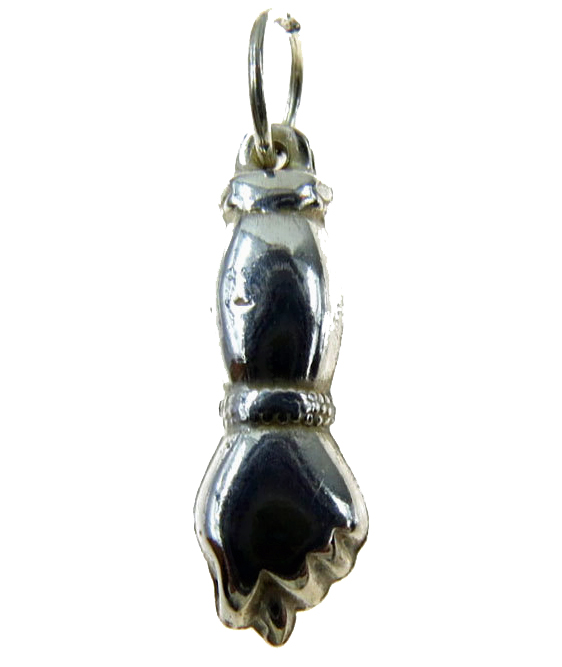
Mano fico is a hand gesture in which the thumb is inserted between the index and middle finger. It means literally means "fig hand" in Italian, but "fica" or fig is a common slang term for the female genitals, so the mano fico is a representation of the sex act (with the thumb as phallus).
Jews may spit three times or say "peh-peh-peh", throw salt, or mutter "kein ayin hara" ("no evil eye") when they feel threatened by the evil eye. They may also make a particular hand gesture, placing the right thumb in the left palm and the left thumb in the right palm and closing their fingers over the thumbs. As with the Italian mano fico gesture, the implication is that of a penis in a vagina; the magical protection of male sexual potency from dehydration through appeal to the female's moist genitalia for aid.
In Iran, Afghanistan, Pakistan, and Tajikistan, Moslem people combine an apotropaic approach with a cure. When a child returns home after taken out among strangers, the parents will light a charcoal disk and burn on it the seeds of a plant called Aspand, while reciting a spell - actually an ancient Zoroastrian prayer - against the evil eye and directing the smoke around the child. This is done as a prophylactic measure, whether or not it is suspected that the child has been given the eye. In some families it is the custom to mingle herb leaves and Frankincense grains with the Aspand to make a more powerful fumigant mixture.
Identifying and Curing the Evil Eye
A mother takes her little toddler to town and someone sees the child and says, "Oh, how pretty she looks! She is just adorable." The admiring person may gaze overlong at the child. If the mother does not take an immediate pre-emptive step - spitting onto the child, denying before God that the baby is attractive, or asking the person who praises the child to touch her or spit on her - the evil eye then begins to operate. By the time the mother and child get home, the child is sick to her stomache and crying. She is flushed, sweaty, and may have diarrhoea. Soon she becomes dehydrated and may be very ill indeed. The mother takes her to a conventional doctor, but "nothing can be done." She finally calls in a local healer - usually an older woman - who diagnoses the true cause of the problem and then performs the cure.
Sometimes the evil eye is diagnosed from the circumstances: the child was well in the morning, was praised or gazed upon, began sweating and vomiting and the cause is clear. But most often the diagnosis and cure involve a complex series of rituals, which vary by culture. Water, oil, and melted wax - liquids - may play a part, or the ritual may center on an eye-shaped and liquid-filled natural object, the egg. Cures, when affected, are usually said to be dramatic, almost instantaneous.
In Eastern Europe, the evil eye is diagnosed by dropping charcoal, coal, or burnt match heads into a pan of water. If the coals float, the child has been given the evil eye.
In the Ukraine, melted wax may be dripped into holy water to diagnose spiritual diseases. If it splatters or sticks to the side of the bowl, the patient is suffering from the evil eye. Secret prayers known only to women are recited and the holy water is used to bathe the victim. The wax is reheated and this time when it is poured into the water, it sinks to the bottom in a solid lump, indicating that a cure has taken place.
In Greece, Mexico, and other places, holy water is given to the child to drink and/or drawn on the child in the form of a cross. If the remorseful perpetrator can be made to spit into the water before the child drinks it, so much the better. In order to avoid direct accusations of having caused such a calamity, a family member may stand outside the church when the supposed perpetrator attends and ask all who pass by to spit into a cup of holy water, thus embarrassing no one.
In Italy, diagnosis is made by dripping olive oil into a basin of water, a drop at a time, while reciting secret prayers, passed only among females in a family. If the drops run together in the form of an eye, the evil eye is the cause of the illness. The cure consists of reciting prayers while dripping oil into the basin of water again and again - sometimes for hours - until a perfect array of oil forms that does not resemble an eye.
In Mexico, both diagnosis and cure are often accomplished with whole uncooked hen's eggs. An egg is rolled across the child's body or placed beneath the bed and then cracked open. If it is "hard" or "looks like an eye" then the evil eye has caused the child's illness.
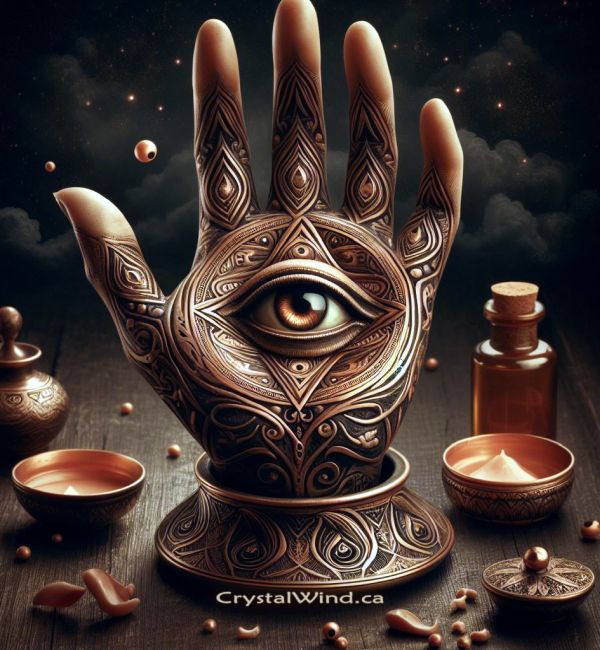
A History of Evil Eye Customs along the Texas-Mexico Border: An Oral Tradition
The following collection of evil eye stories was made by Soledad Perez among "the Mexican people of Austin, Texas" in the fall and spring of 1948 and 1949. The commentary is hers as well. This material appears in "The Healer of Los Olmas and Other Mexican Lore."
EVIL EYE
The evil eye is an ailment common among small children. It is believed that it is caused by excessive affection. If a woman or a man sees a child with physical attributes which he admires, he must touch the child and invoke God's protection so that the baby will not suffer from the evil eye.
Children seem to be most susceptible to this ailment, although adults may suffer from it occasionally. Babies suffer the direst consequences. They have a very high fever, a lack of appetite and sleep, and usually a swelling on some part of the body. So if a woman casts an evil eye on a child's hand, it will be swollen and red.
In most instances, the cure for evil eye is simple. It consists in passing an unbroken egg over the face and body of the victim, sweeping him, or transferring three mouthfuls of water from the mouth of the person casting the evil eye to the mouth of the victim.
After the cure, precautions must be taken in the disposal of the egg or eggs used. They must be thrown out in a shady place or buried. If the sun's rays strike them, the evil eye will attack the victim anew. (For evil eye cf. D2071 and D2064.4 in Thompson's Motif-lndex.)
EVIL EYE (1)
When a person suffers from the evil eye, he says, "I was given the eye." To cure this, an unbroken egg is passed over his face. Afterwards, the egg is broken in a saucer, and it is placed under the bed.
Another remedy is to find the person who cast the evil eye and force this person to give the victim three mouthfuls of water.
In order to decide whether a person is suffering from the evil eye, the egg placed under the bed must be examined after the cure has been administered. If a white membranous film appears over the egg, it means that the person who gave the evil eye is a man. If only an eye appears on the egg, it means that the person who cast the evil eye is a woman."
(Informant 3.)
EVIL EYE (2)
When Chita was small, I took her down town on one occasion. She was a pretty little girl, and people admired her. While I was standing at the counter of one of the department stores, a little Mexican woman approached me and wanted to touch Chita. She said, "What a pretty baby! Won't you let me touch her hair and eyes?"
I didn't like for people to be touching the baby; so I said, "No, please don't touch her!"
The little woman left, and I didn't believe in the evil eye; so I thought no more about it.
The next day Chita became ill. She had a very high fever and was flushed and uneasy. I called the doctor. He came and looked at her. Two or three days went by, and Chita didn't improve. She just seemed to get worse. We went from one doctor to another, but it didn't do any good.
Finally one day my comadre Mrs. Ramos came over, and she looked at Chita and said, "This child is suffering from the evil eye. I can cure her if you will let me try."
I told her to go ahead; and she did. She asked for two eggs and a cup. One of the eggs she passed over Chita's whole face. Then she took the egg, broke it, put it in a cup stirred it, and made a cross with some of it on Chita's forehead. While doing this she pronounced several prayers. The other egg she placed on the mantelpiece in the living room and asked that no one touch it.
The next day Mrs. Ramos came back. Chita's fever was gone, and you could tell that she was better. Mrs. Ramos then took the egg from the mantelpiece and broke it. If I hadn't been there, I wouldn't believe it, but my husband and I both saw it. The egg looked as if it were hard-boiled. Mrs. Ramos said, "Chita will get well now. The evil eye has gone into the egg; that's why it looks like this."
Chita got well.
(Informant l.)
EVIL EYE (3)
In my home, whenever anyone became ill my aunt was called.
On one occasion it was believed that my little brother had the evil eye. My aunt came and passed an unbroken egg over my little brother's face. Then she broke the egg, and taking some of it, she made a cross on his forehead. After that she said several prayers and swept my brother from head to foot. She took another egg, broke it, put it in a saucer, and left it under the bed. Later, when my aunt took the egg out from under the bed, she said that she could tell my brother had been suffering from the evil eye because an eye had formed in the egg.
(Informant 17.)
Both Perez's introduction and the second collected story accord with the notion that *touching* the child dispels the eye or prevents it from being cast. In story #2, the mother all but admits that it was her mistake in not letting the admiring woman *touch* her daughter that led to the child coming down with the evil eye.
Charms to Ward Off the Evil Eye
A mother whose child has once been struck by the evil eye will soon take the advice of the other women in her community and acquire an amulet for the child to wear to repel the evil eye in the future. This sort of charm is called a repellent talisman or apotropaic charm.
The design of these charms varies from one area to another. The simplest are threads or cords, often red. More conspicuous are the amulets, often in the form of an eye, a hand, a horseshoe, or combinations of two elements, such as the popular eye-in-hand and horseshoe-and-eyes. There are other, locally popular charms as well that derive from other iconographic and symbolic sources.
In Greece and Turkey, the most common form of apotropaic charm is the blue glass eye charm, which "mirrors back" the blue of the evil eye and thus "confounds" it. Turks make beautiful blue blown glass charms in the all-seeing eye and eye-in-hand patterns, as well as in regionally-specific forms I call the horseshoe-and-eyes and eyes-all-over styles. Modern Turkish women - and Americans who like the "look" - wear jewelry-quality sterling silver evil eye bracelets, made not only in the traditional shades of blue, but in ultra-hip fashionable colours. For a further account of some Turkish charms designed along these lines see the web page called "Your Name On Rice," in which I describe meeting a Turk who made and sold blue blown glass eye-charms on the streets of Berkeley, California.
Among the ancient Egyptians the eye of the god Horus, called the wadjet or udjat eye, was worn for magical protection. Although found in many materials, by far the most numerous are those made of blue-glazed faience or steatite.
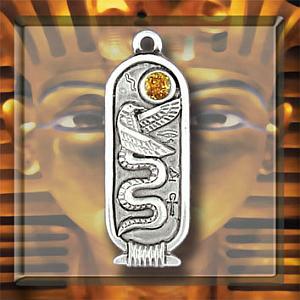
In the Middle East, turquoise blue faience beads ("donkey beads") are used to protect livestock from the evil eye. These beads can be seen dangling from a modern Egyptian luck-bringing and apotropaic blue glazed wall plaque in the form of a horseshoe, made in Egypt.
In India, cord charms strung with a blue bead are placed on newborn babies; when the cord decays and breaks and the blue bead is lost, the child is considered old enough to have escaped the dangers of the evil eye.
Among the Kalbeliya Gypsies of India (the tribe from whom the European or "Bohemian" Gypsies are descended), the "mirroring back" of the evil eye takes the literal form of fabulously ornate multi-coloured mirror charms which are crocheted, braided, and wrapped with beads, buttons, and tassels. The practice of crocheting hundreds of tiny mirrors into fancy cloth - especially wedding garment cloth - is also widespread in parts of India.
In Nepal, where a hybrid form of religion called Tibetan Buddhism combines elements of the old animist beliefs with reverence for Gautama Buddha, a wonderful amulet called the eye of Buddha is worn to reflect back the evil eye.
In contemporary U.S. novelty catalogues, one can see advertisements for a so-called "eerie eye charm" which is a life-like blue eye set in an eyelid-shaped bezel.
In addition to blue bead eye-charms, numerous other eye-design and hand-design amulets are used to repel the evil eye.
One of the oldest forms of hand-talisman is the Roman hand of power, a bronze votary of a hand covered with symbolic images that was kept on the home altar to protect and bless the entire family.
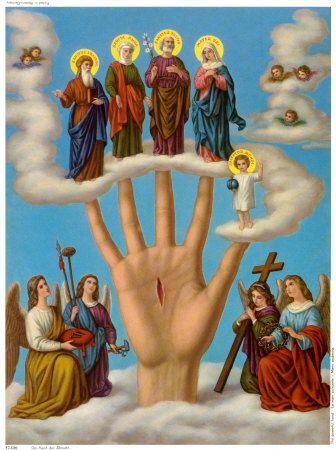
In countries where Catholicism is the dominant religion, a Christianized version of the Roman hand of power is given traits of the eye-in-hand and the resultant image is called "the Most Powerful Hand of God" or mano poderosa. In this apotropaic charm - usually carried on the person in the form of a holy card or, as in Peru, as a protective package amulet, the symbolic images that cover the hand have been replaced by saints and a gaping crucifixion wound represents the eye in the palm.
In India, Israel, and the Arab countries the eye-in-hand charm is common. It may be carved of bone or cast in metal, with an engraved image of an eye in the palm or a cabochon-cut stone standing in for the eye.
The Middle East is home to the hamsa hand or hamesh hand charm (also known as the hand of Fatima among Arabs and the Hand of Miriam among Jews). This hand-shaped apotropaic charm may be cast in metal and worn as jewelry, but larger ones, inscribed with prayers of magical protection are often made of blue-glazed ceramics and hung on a wall.
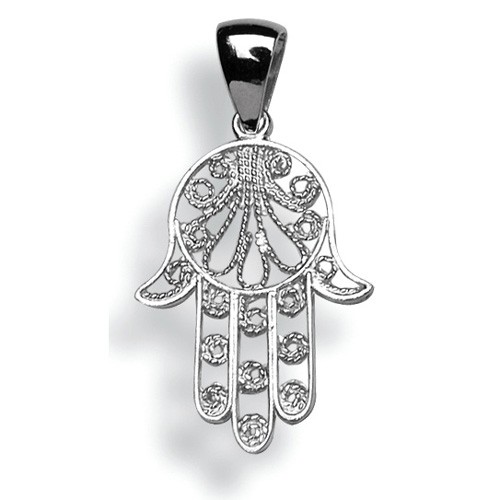
In North Africa, a cabochon cut eye-agate stone may be used in conjunction with the hamsa hand design.
In America and England, jewelry-quality charms have been made from cat's eye shells. The eye-like shells are also carried in the pocket for personal magical protection.
In Sicily a lemon (a liquid-filled, eye-shaped fruit) may be pierced with nine nails and placed above doorway to prevent a jettatore from entering.
In Naples a piece of the rue plant (which has eye-shaped fruits and a strongly repellent odour) may be pinned to the clothes or a silver charm made to vaguely resemble the plant, and called a cimaruta ("sprig of rue") may be worn as a necklace.
Red is another color employed against the eye, mostly in regions where blue is not used: Red cords around the neck or wrist protect babies in Eastern Europe and also in India. Likewise it is an old Jewish custom to place a red thread on a baby to protect it from ayin ha'ra.
In Mexico a large brown legume seed that resembles an eye, called ojo de venado ("deer's eye"), is hung from a red cord and outfitted with a fluffy red tassel and a holy print of a saint. It can be worn on the person, hung over the baby's crib, or dangled from the rear-view mirror of a car to ward off the evil eye.
In Italy, when a man's potency is threatened by the evil eye, gold or silver hand charms making the mano fico ("fig hand") and mano cornuta ("horned hand") gesture are used to repel the evil. These amulets are usually carved of blood red coral, and sometimes found in silver or gold. They are worn as necklaces, watch fobs, and pocket pieces by men and boys.
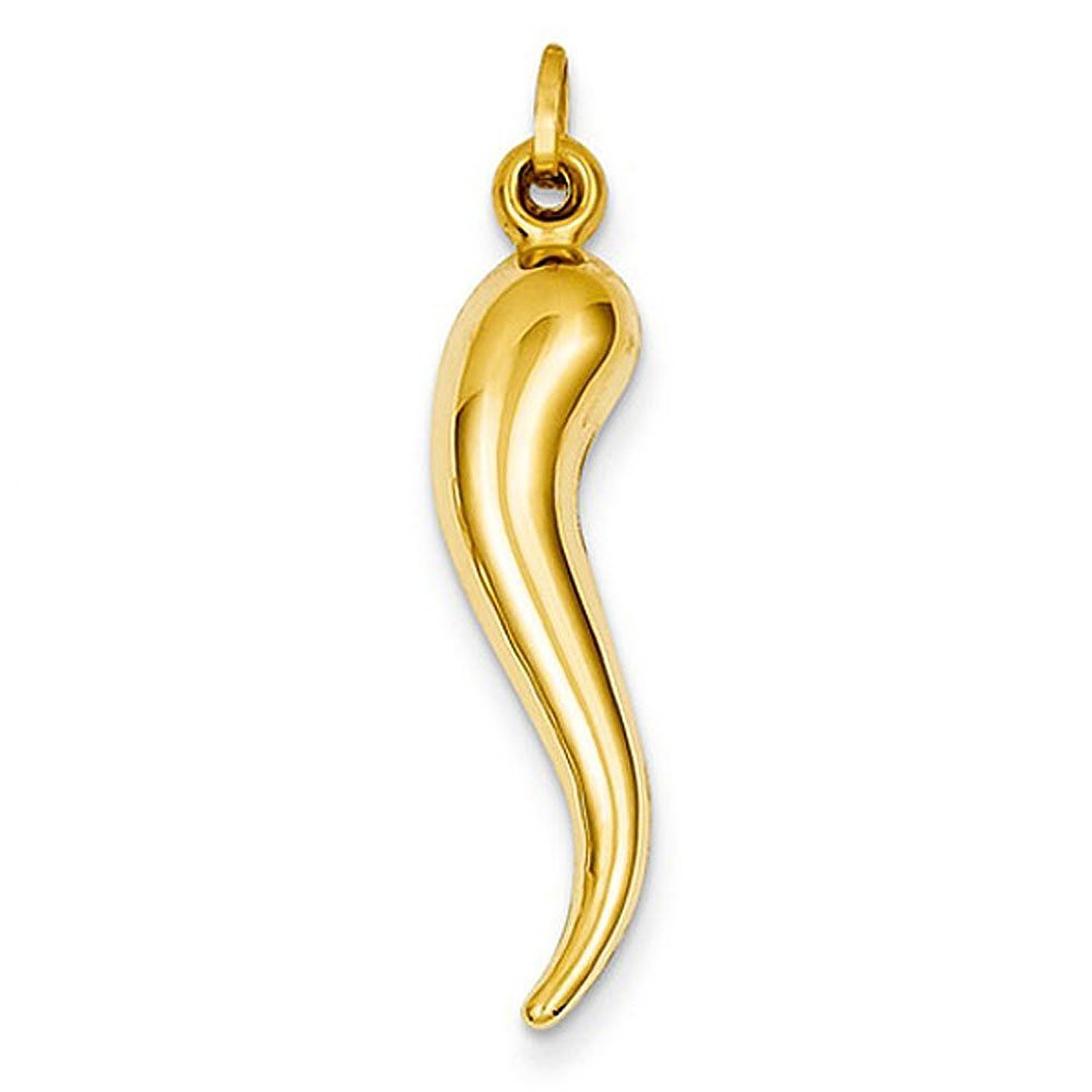
Corno (horn) or cornicello (little horn) is the name for an Italian amulet that looks like a long, twisted animal horn, rather freeform in design, usually carved of blood coral, but also found in red plastic, silver, gold, or blown glass. In America it is called "the Italian horn." Due to its phallic shape, it is usually only used by males.
A naturally branched piece of red coral "twig" is sometimes worn in place of the Italian horn amulet, and it may be made into a pin rather than a hanging amulet and then may be worn by a woman or girl.
Carved red coral amulets in the form of the mano fico, the mano cornuta and the corno were everywhere in Italy when I travelled there as a child with my parents in 1957. Every town had a jewelry store that sold them and all the men seemed to be wearing them. I wanted one badly, but my mother explained that I could not have one because only boys were given them to wear and I would be breaking a cultural taboo. They are, as she explained to me, a specific against impotence.
More recently, Italian-American women have taken to wearing such "male" amulets as the corno but now that I am collecting these things and don't care what people think of my interest in "men's" as well as "women's" mysteries, I find that although tiny red coral cornicelli can still be had (for a high price), coral mano fico hands are comparatively rare, due to the near extinction of Mediterranean coral, caused by water pollution and over-harvesting. Reproductions in pewter are sometimes found in America.
In ancient times, the moon goddess was invoked as a protectress of babies, nursing mothers, and milk animals, so her lunar crescent was used as an apotropaic charm. The previously mentioned North African eye-agate, crescent, blue bead, and hamsa hand charm is an old example of this usage.
An ancient Egyptian charm that combines the protective colour red with the protective power of a mother goddess is the so-called buckle of Isis charm or tit amulet. In fact, this amulet represents the menstrual pad of the goddess; it protects nursing mothers (Isis is generally shown suckling her son Horus) and young babies.
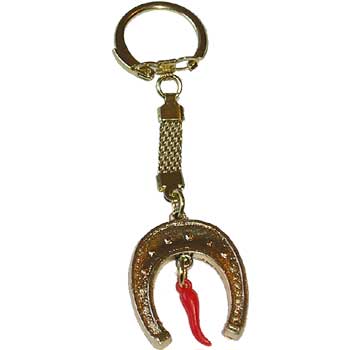
The use of a horseshoe to represent the lunar crescent is also ancient. Throughout Europe horseshoes are nailed to doors to prevent the evil eye from entering houses and barns. (The horseshoe charm has also acquired a second function, to "draw" luck to the bearer just as a horseshoe-magnet might attract iron filings or magnetic sand.)
In the days before automobiles came into use, draft horses and donkeys that pulled cabs and wagons in towns, where many people might see and admire them, were protected from the evil eye by apotropaic charms. In addition to the Middle Eastern blue faience donkey beads and Gypsy mirror charms mentioned above, locally popular amulets for animals include a scrap of wolf's fur (Naples), bells (all of Europe), images of mermaids called Sirens (Naples), and ornamental "horse brasses," often cast in the form of a lucky horseshoe (England).
I have dozens of examples of the above apotropaic amulets hanging on the wainscoting of the wall to my right as I sit in my office and type, and a few have overflowed onto the Lucky W Windowsill, where the morning sunlight is playing upon them gently. My livestock and my child are very, very safe.
An Overview of the Global Beliefs Surrounding the Evil Eye
PERPETRATORS
- Envious people
- Those who praise children
- Those who suffer from covetousness
- Those with blue eyes (xenophobia among brown-eyed racial groups)
- Childless women
- People born with the unfortunate propensity to inadvertently project the eye
ETIOLOGY
- Overlooking (old British term; means gazing too long upon coveted item or child)
- Praising without touching or spitting to void the damage
- Projection from eye (Sicilian term for one who gives mal occhio is jettatura, from the same root-word as ejaculation and projection)
VICTIMS (AND SYMPTOMS)
- Nursing infants (they sicken and cry; their mother's milk may dry up)
- Young children (they sicken and cry; they may vomit or become listless)
- Milk cows and milk goats (they dry up)
- Fruit trees (they wither and die or they do not bear fruit)
- Fathers and sons (orphans or fathers who have lost sons envy them)
- Adult men (they become impotent)
- (Note: as Prof. Dundes points out, most of these symptoms involve the loss of FLUIDS.)
APOTROPAIC CHARMS and GESTURES
- Refusal to accept praise on behalf of child
- Spitting on child
- Spot of soot or dirt on child so child will not look pretty
- Formulaic phrases
- Protective hand gestures
- Eye amulets (e.g. wadjet eyes, blue-eye charms, ojo de venado)
- Eye-in-hand amulets
- Hand of power and powerful hand images
- Hamsa hand or hand of Fatima / hand of Miriam
- Eye-agate amulets or jewelry
- Cat's-eye shells
- Blue beads
- Cord charms that decay and release a blue bead
- Mirror charms
- Fumigation with Aspand seeds burned on charcoal and recitation of spell
- Amulets that replicate protective hand-gestures
- Red thread or cord
- Red coral horns and twigs
- Buckle of Isis amulets
- Horseshoes
- Crescent-shaped objects
(Note: Some of these involve reflective imagery, others are protective.)
CURES
- Olive oil dripped into water with prayer
- Wax dripped into water with prayer
- Coals or match heads dropped into water with prayer
- Passing a whole raw egg over the face, then breaking it
- Breaking an egg in a dark, shadowed place, unseen
- Breaking an egg and drawing a cross on the victim's forehead
- Throwing an egg into the bushes or against a tree (if tree is victim)
- Placing a broken egg in dish beneath victim's bed
- Piercing a lemon with iron nails
- Victim drinks three sips of holy water
- Victim is bathed in holy water
- Victim spits at giver of evil eye three times
- Water or spittle from inadvertent perpetrator is passed to mouth of victim
- Collection of spittle from group (anonymous donation); victim drinks spittle in holy water
(Note: As Dundes points out, these involve use of fluids and/or eye-shaped objects (egg, lemon) which contain fluid within them)
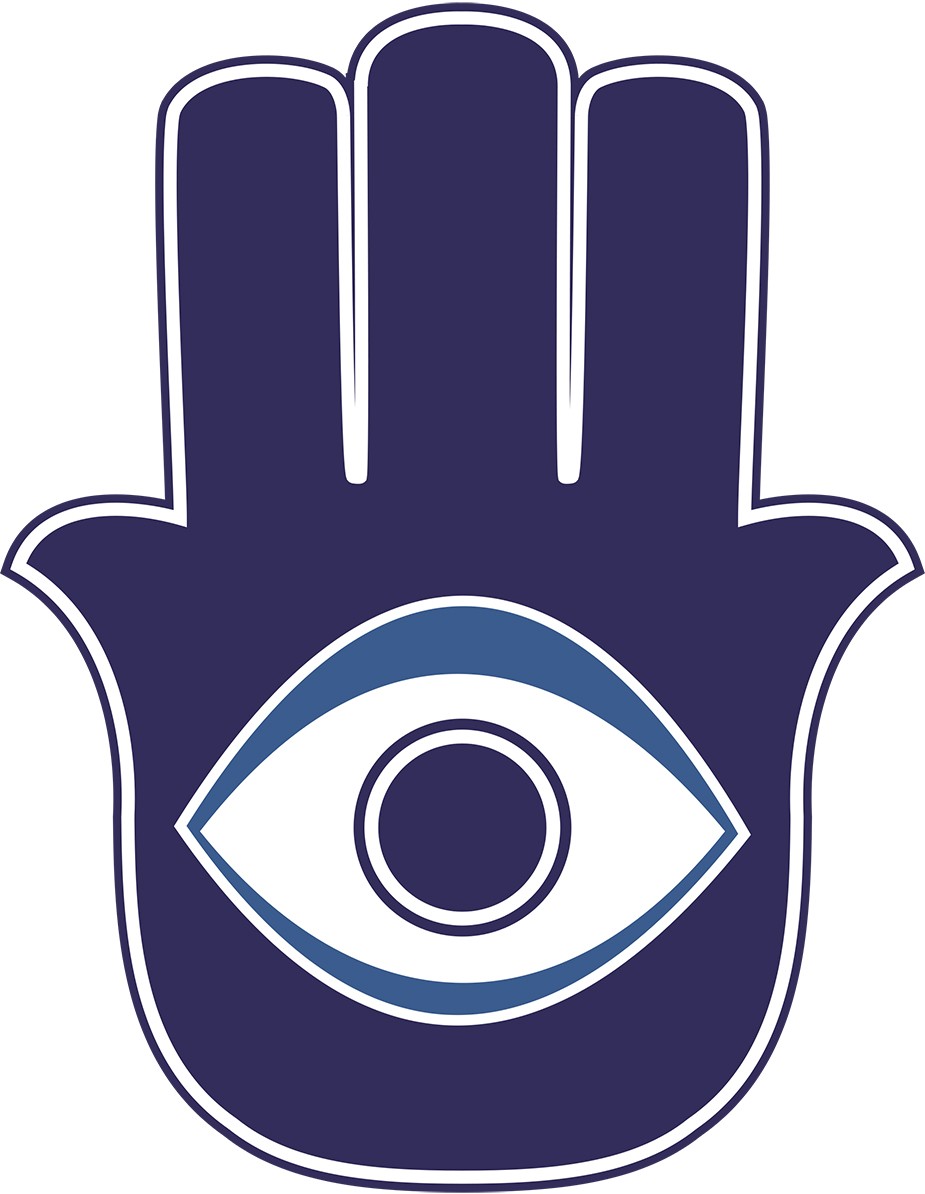
© 2009-2024 crystalwind.ca. All rights reserved. Hidden tracking code is embedded for monitoring purposes. We employ sniffer technology to track all IP addresses. Please note that using a Proxy/VPN/Tor will not conceal your IP address. The title for this article was created by CrystalWind.ca. If this article is duplicated from our website and/or our title is utilized, we will be alerted and will take necessary action.
Liked this article? Dive deeper into personal growth and wellness! Check out CrystalWind.ca for spiritual wisdom or explore AromaWorx.ca for natural well-being tips. Spread the positivity—share this with friends on their happiness journey!
Let’s Chat! Drop Your Thoughts Below! ![]()
Latest Articles
Articles: Emerald Tablets

Imagine a world of inspiration and healing, free for all—made possible by YOU!
Donate Now—Ignite the Magic at CrystalWind.ca!

Epilepsy - Finding A Cure
Your donation can make a difference!
Help us find a cure – donate now!
Unlock Your Light: Join Lightworkers Worldwide on CrystalWind.ca!
Articles: Alchemy
Articles: Ancient Egypt
Articles: Labyrinths
Articles: Pyramids
Articles: Superstitions
Follow Us!
Featured This Month
Mabon in Modern Times: Fresh Takes on the Au…
The Mabon season begins somewhere around the 21st-22nd of September and cont... Read more
Watermelon Tourmaline
Synonym: Rainbow Tourmaline The watermelon tourmaline is a rare variety t... Read more
Sun in Virgo
An Overview of Sun Sign Characteristics for Virgo Virgo is guided by Mercur... Read more
Mabon Magic: Ideas For Fall Decoration And R…
Welcome (almost!) to Fall! We’re turning the Great Wheel once again, toward ... Read more
Peridot: The Healer's Stone
Peridot has been used as a Power Stone for centuries. Peridot fosters emotio... Read more
Sweet Violet
Sweet Violet Faithfulness and modesty. “I will always be true to you.” Helps... Read more
Virgo Mythology
The Virgo Myth In all of constellation mythology, few legends are as misund... Read more
Crystals for Virgo
As the warmth of summer begins to soften into the crispness of autumn, the Sun... Read more
The Vine: September 2nd - September 29th
The Autumnal Equinox ( Alban Elfed ) Celtic Symbol : The White Swan Read more












































